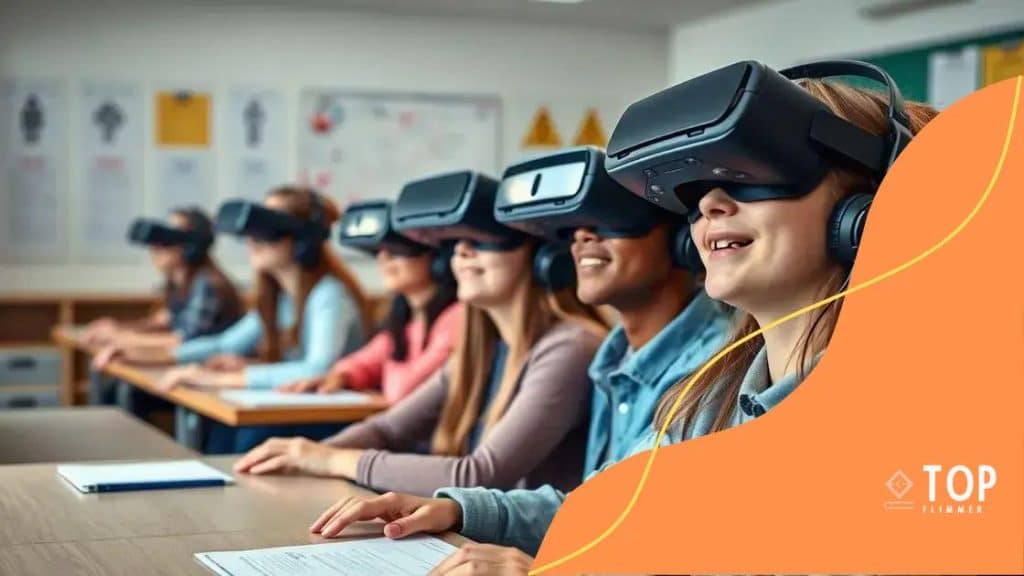Virtual reality in education: a transformative approach

Virtual reality in education transforms learning by providing immersive experiences that enhance engagement, collaboration, and the application of practical skills, while also presenting challenges like costs and technical requirements.
Virtual reality in education is changing the way students interact with learning materials. Imagine diving into ancient civilizations or exploring the human body through an immersive experience. Curious about how this technology reshapes education? Let’s explore!
Understanding virtual reality and its applications
Understanding virtual reality is essential for recognizing its potential in various fields, especially in education. This immersive technology allows users to experience lifelike environments while interacting with 3D objects. By simulating real-world scenarios, virtual reality provides learners with unique opportunities to practice skills and deepen their understanding of complex subjects.
In educational settings, virtual reality can be a powerful tool for engaging students. Through interactive lessons, students can explore history, science, and art in ways that traditional learning methods cannot replicate.
Applications of Virtual Reality in Education
There are numerous applications for virtual reality in the classroom:
- Virtual Field Trips: Students can visit faraway places, like Mars or ancient Egypt, without leaving the classroom.
- Simulations: Medical students can practice surgeries or procedures in a safe, controlled environment.
- Hands-on Learning: Subjects like chemistry can become more engaging as students safely experiment with virtual compounds.
- Collaboration: Students can work together in a shared virtual space on projects and presentations.
Through these applications, students not only gain knowledge but also develop important skills such as critical thinking and collaboration. As they work within these immersive environments, they become more invested in their learning.
Furthermore, the use of virtual reality can cater to different learning styles. Some students learn best through visual or auditory methods, while others need hands-on experiences. With virtual reality, educators can create tailored experiences for each student, enhancing overall engagement and retention.
As we delve deeper into this technology, it is crucial to consider the potential challenges, including accessibility issues and the need for specialized equipment. However, the advantages of using virtual reality in education are vast and promising.
The role of VR in enhancing student engagement
Virtual reality (VR) plays a vital role in enhancing student engagement in classrooms around the world. This innovative technology creates immersive experiences that capture the attention of learners, making them more motivated to participate. When students are engaged, they are more likely to retain information and develop a passion for learning.
Using VR, teachers can create interactive lessons that allow students to explore topics like never before. They can step inside historical events or dive deep into scientific concepts, transforming abstract ideas into tangible experiences.
Benefits of VR for Student Engagement
The integration of VR into education brings several benefits:
- Active Participation: Students become active participants in their learning process rather than passive recipients of information.
- Real-World Applications: VR simulations can showcase real-world scenarios, helping students understand practical implications.
- Collaboration: VR enables group activities, allowing students to work together on projects and solve problems collaboratively.
- Increased Retention: Engaging experiences help improve memory retention, making it easier for students to recall what they’ve learned.
Furthermore, VR allows for personalized learning experiences tailored to individual needs. For example, students who may struggle with traditional learning methods can thrive in a virtual setting that caters to their unique learning style. This adaptability is key to fostering a love for learning.
As educators embrace VR technology, they open doors to a wealth of educational opportunities. The excitement of putting on a headset and entering a new world encourages students to explore content actively, sparking curiosity and creativity.
Overall, the role of VR in enhancing student engagement cannot be overstated. It shifts the focus from lectures to interactive, experiential learning, transforming how students absorb and connect with the material.
Benefits of immersive learning experiences

Immersive learning experiences offer incredible benefits for students in today’s educational landscape. These experiences engage multiple senses, allowing learners to absorb information in a more impactful way. By stepping into a virtual environment, students can interact with the subject matter, which often leads to deeper understanding and retention.
One major benefit is the ability to explore complex concepts through hands-on interaction. For instance, in a virtual science lab, students can conduct experiments safely, without the risks associated with real-life setups. This active participation reinforces their learning and builds confidence.
Enhanced Engagement
Immersive learning environments are designed to captivate students’ attention:
- Increased Motivation: When students are excited about what they are learning, they are more likely to participate and perform well.
- Real-Life Applications: Students see the relevance of their lessons through simulations that mimic real-world scenarios.
- Instant Feedback: Virtual environments can provide immediate assessments, allowing students to learn from their mistakes quickly.
- Social Interaction: Many immersive experiences encourage collaboration, helping students develop teamwork skills.
Moreover, these experiences can cater to diverse learning styles. Visual learners benefit from seeing concepts in action, while kinesthetic learners enjoy the hands-on approach. This adaptability ensures that all students can engage fully, leading to a more inclusive classroom environment.
As students navigate through different virtual scenarios, they develop critical thinking and problem-solving skills. They learn to make decisions and face challenges that require thoughtful analysis. This preparation is invaluable as they transition into real-world situations.
In conclusion, the benefits of immersive learning experiences are profound. From enhancing engagement to fostering essential skills, these experiences reshape how students learn and interact with educational content.
Challenges of implementing VR in classrooms
Implementing virtual reality in classrooms presents several challenges that educators and institutions must navigate. While the benefits are clear, the road to integrating this technology can be complex and demanding.
One major challenge is the cost of the necessary hardware and software. Quality VR headsets and compatible systems can be expensive. Many schools face tight budgets, making it difficult to invest in such technologies. As a result, some educators may hesitate to adopt VR, worrying about the financial implications.
Technical Limitations
Aside from costs, technical limitations also pose a barrier:
- Infrastructure: Schools must have reliable high-speed internet and appropriate hardware to support VR.
- Training: Both teachers and students need training to use VR effectively. This additional learning curve can slow down the implementation process.
- Maintenance: Technology can fail; schools need a plan for regular maintenance and updates to keep VR systems running smoothly.
- Compatibility: Not all educational content may be compatible with existing VR systems, limiting the resources available.
Furthermore, there are concerns about student accessibility. Not all students may have the same level of comfort with technology. Some learners may experience motion sickness or find it challenging to navigate virtual environments. This can make VR less beneficial for those students compared to traditional learning methods.
Another vital consideration is the potential for distraction. With the immersive nature of VR, students might focus more on the technology than the lesson. This requires careful planning from educators to ensure that the technology enhances, rather than detracts from, the learning experience.
Despite these challenges, many educators believe that the potential of virtual reality makes overcoming them worthwhile. By addressing these obstacles, schools can unlock new opportunities for engaging students in meaningful ways.
Future trends in virtual reality education
The future of virtual reality in education looks promising, with several trends emerging that could reshape how students learn. As technology advances, VR is becoming more accessible and integrated into various educational settings.
One key trend is the increasing use of affordable VR technologies. As prices for headsets and software decline, more schools will be able to invest in this technology. This accessibility can lead to greater adoption across diverse educational institutions.
Blended Learning Environments
In the future, we can expect to see more blended learning environments where VR complements traditional teaching methods. This means students will not only attend lectures or read textbooks but also engage in immersive learning experiences. For instance:
- Field trips: VR can take students on virtual field trips to historical sites or scientific centers.
- Interactive lessons: Students can participate in simulations that allow for hands-on learning in subjects like science and history.
- Remote learning: Students who learn from home can also have access to rich virtual experiences that keep them engaged.
Another significant trend is the development of collaborative VR experiences. Students from different locations can connect in a virtual space, working together on projects in real time. This fosters teamwork and communication skills as they engage with peers worldwide.
Furthermore, there’s a shift towards personalized learning experiences using VR. By tailoring lessons to fit individual student needs, educators can address various learning styles and paces. This could lead to better academic outcomes and increased student satisfaction.
As VR technology continues to evolve, educators will also have access to more robust analytics. These tools can track student engagement and performance in real time, providing insights that help teachers refine their methods and improve learning outcomes.
FAQ – Frequently Asked Questions about Virtual Reality in Education
What is virtual reality in education?
Virtual reality in education is a technology that creates immersive learning experiences, allowing students to engage with content in a more interactive way.
How does VR enhance student engagement?
VR enhances student engagement by making learning fun and interactive, encouraging active participation and collaboration among students.
What are the challenges of implementing VR in classrooms?
Challenges include high costs, technical limitations, and the need for training teachers and students to use the technology effectively.
What are the future trends in virtual reality education?
Future trends include the use of affordable VR tools, blended learning environments, and personalized experiences that cater to individual learning needs.






